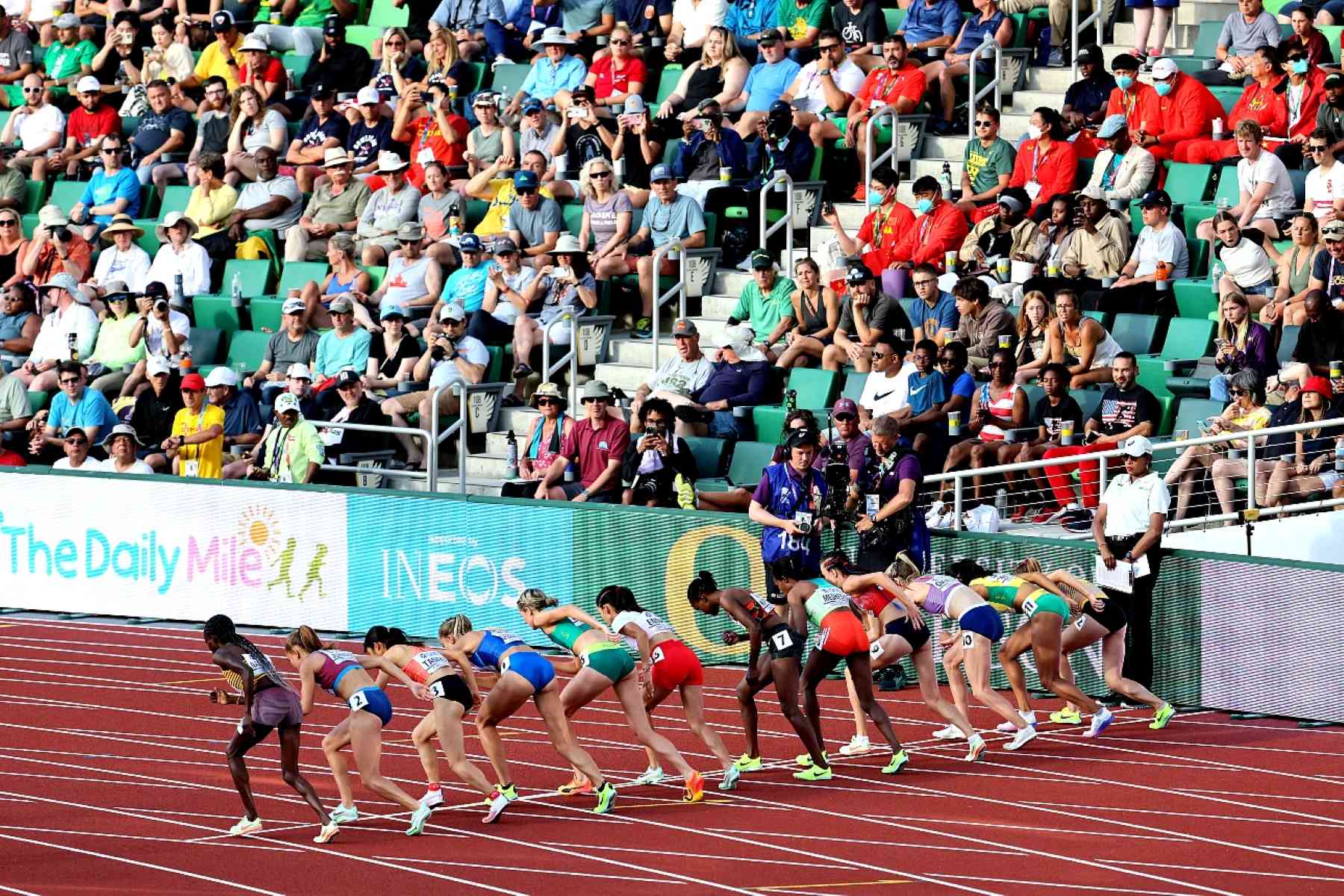Home>Misc>Featured>How Often Is The Track And Field World Championships


Featured
How Often Is The Track And Field World Championships
Modified: August 21, 2023
Discover the featured track and field events at the World Championships. Learn how often this prestigious event takes place and stay updated on all the thrilling competitions.
Introduction
The Track and Field World Championships, commonly referred to as the “World Athletics Championships,” is a global sporting event that showcases the best athletes from around the world in various track and field disciplines. This prestigious competition is organized by World Athletics, the international governing body for the sport of athletics.
Since its inception, the World Championships have grown to become one of the most highly anticipated events in the athletics calendar. The championships provide a platform for athletes to demonstrate their skills and compete at the highest level, while also captivating audiences with their extraordinary performances and record-breaking achievements.
The history of the Track and Field World Championships dates back to 1983, when the inaugural edition was held in Helsinki, Finland. Over the years, the championships have evolved to encompass a wide range of athletic disciplines, including sprints, distance running, hurdles, jumps, throws, and relays.
With an ever-increasing global interest in athletics, the popularity and significance of the World Championships continue to grow. The event attracts millions of viewers from across the globe, as well as thousands of spectators who attend the championships in person, creating a vibrant and electrifying atmosphere.
Not only do the Track and Field World Championships provide a stage for elite athletes to compete against each other, but the event also serves as a platform for fostering camaraderie and cultural exchange between nations. Athletes from different backgrounds and nations come together to showcase their skills, forge friendships, and celebrate the universal spirit of sportsmanship.
As the Track and Field World Championships have become a staple event in the athletic world, the frequency with which the championships are held has become a topic of interest and debate. On one hand, frequent hosting can maintain momentum and excitement surrounding the event. On the other hand, less frequent hosting allows for longer preparation periods and the opportunity to showcase the event on a grander scale.
In the following sections, we will delve into the history, frequency, hosting locations, importance, and controversies surrounding the Track and Field World Championships. By exploring these aspects, we can gain a comprehensive understanding of this enthralling event that captivates the hearts and minds of athletes and fans worldwide.
History of the Track and Field World Championships
The Track and Field World Championships originated from the desire to create a dedicated global platform for showcasing the talents and achievements of track and field athletes. The inaugural edition took place in 1983 in Helsinki, Finland, and was organized by the International Association of Athletics Federations (IAAF), now known as World Athletics.
Since its inception, the championships have been held biennially, with only a few exceptions. Initially, the event was held in the same year as the Olympic Games. However, starting from 1991, the championships were scheduled to take place in odd-numbered years, alternating with the Summer Olympics.
Over the years, the Track and Field World Championships have evolved in terms of the number of events and participating nations. The inaugural edition featured a total of 41 events, including both men’s and women’s disciplines. As the championships gained popularity and recognition, more events were added, expanding the range of competitions to accommodate a broader spectrum of athletic specialties.
One of the significant milestones in the history of the championships was the inclusion of para athletics events in 2011. This decision marked a significant step forward in promoting inclusivity and providing opportunities for athletes with disabilities to compete at the highest level.
Another notable aspect of the championships is the record-breaking performances that have taken place throughout its history. Legendary athletes such as Usain Bolt, Carl Lewis, Florence Griffith Joyner, and Sergey Bubka have left their mark by setting world records and delivering awe-inspiring performances that have mesmerized audiences worldwide.
The host cities for the championships have spanned the globe, with various countries having the privilege of welcoming the world’s top athletes. From the iconic venues of Paris and London to the cultural hubs of Beijing and Moscow, each host city adds its unique charm and atmosphere to the event.
As the championships continue to attract a growing number of participants and spectators, they have become a platform for athletes to leave a lasting legacy. The event serves as a stage where new talents emerge, established stars shine, and records are shattered, creating timeless moments that become etched in the annals of sports history.
In the following sections, we will explore how often the Track and Field World Championships are held and the factors that influence the frequency of this legendary event.
Frequency of the Track and Field World Championships
The Track and Field World Championships are held biennially, meaning they take place once every two years. This regular interval provides athletes with consistent opportunities to showcase their skills and compete on the global stage.
However, it is important to note that the frequency of the championships has not always been consistent throughout its history. In its early years, the event was held in the same year as the Summer Olympics, creating a thrilling double-header of elite athletic competitions for fans and athletes alike.
Starting from 1991, the World Championships were rescheduled to occur in odd-numbered years, specifically the years between Olympic Games. This change aimed to minimize conflicts with the Summer Olympics and allow athletes more time to recover and prepare for both events.
The decision to hold the championships every two years provides a balance between maintaining the event’s momentum and ensuring sufficient time for athletes to recover and train for the next edition. This frequency allows athletes to plan their training and competition schedules effectively, as they know well in advance when the next World Championships will take place.
Additionally, the biennial frequency allows for the championships to remain a highly anticipated and prestigious event within the athletics community. Athletes have the opportunity to build their careers around the World Championships, aiming to peak at these pinnacle competitions and leave their mark on the global stage.
Moreover, the two-year interval allows World Athletics, the governing body of track and field, to coordinate and implement necessary organizational and logistical preparations for the championships. Host cities have ample time to plan and build the necessary infrastructure, ensuring a successful and memorable event for both athletes and spectators.
While the current frequency of the Track and Field World Championships has been well-received by athletes and fans alike, there have been discussions and debates regarding the possibility of hosting the event more frequently. Some argue that a more frequent hosting schedule, such as an annual event, would maintain consistent excitement and engagement within the athletics community.
However, there are significant factors that need to be considered when discussing the possibility of increasing the frequency of the championships. Hosting such a large-scale sporting event requires substantial financial investments, infrastructure development, and logistical planning. Increasing the frequency could potentially strain the resources of both the host city and World Athletics.
Ultimately, the current biennial frequency strikes a balance between sustaining the event’s prestige and allowing sufficient time for athletes to prepare. It ensures that the Track and Field World Championships remain a highly anticipated and celebrated competition, showcasing the best athletes from around the world.
In the next section, we will delve into the factors that influence the frequency of the Track and Field World Championships and the significance of the event in the global athletic landscape.
Factors Influencing the Frequency of the Championships
Several factors come into play when determining the frequency of the Track and Field World Championships. These factors have a significant impact on the logistics, scheduling, and overall organization of the event.
One of the key considerations is the global athletics calendar. The Track and Field World Championships aim to provide athletes with ample opportunities to compete at the highest level. Therefore, it is important to align the event’s frequency with other major competitions, such as the Olympic Games and continental championships.
The coordination between World Athletics and other governing bodies ensures that athletes have sufficient time for preparation, qualification, and recovery between competitions. This helps maintain the integrity and quality of the World Championships and allows athletes to showcase their peak performances.
Funding and resources also play a vital role in determining the frequency of the championships. Hosting such a large-scale event requires significant financial investments from both World Athletics and the host city. The availability and allocation of resources impact the feasibility of hosting the championships on a more frequent basis.
Moreover, the infrastructure required to host the championships, including stadiums, training facilities, and accommodations, takes time to plan and develop. Holding the event every two years provides host cities with suitable time frames to construct and upgrade the necessary infrastructure to ensure a successful and memorable experience for athletes and spectators.
The athletes themselves are another crucial factor in determining the frequency of the championships. Athletes need sufficient time to train, recover, and compete in various other competitions. Hosting the championships too frequently could lead to fatigue and excessive strain on the athletes, potentially affecting their performance and overall well-being.
Another consideration is the global appeal and viewership of the championships. The event draws millions of viewers worldwide, and the frequency of the championships ensures that the excitement and anticipation remain high. Holding the event biennially helps maintain the allure and interest among fans, ensuring sustained engagement and viewership.
Lastly, organizational factors, such as the planning and coordination of the event, influence how often the championships are held. The logistics of arranging venues, accommodation, transportation, and various other operational aspects require careful consideration and preparation. A biennial frequency allows for adequate time to organize and execute these logistics effectively.
Considering all these factors, the current biennial frequency strikes a delicate balance between providing athletes with regular opportunities to compete at the highest level and allowing sufficient preparation time. It ensures that the Track and Field World Championships remain a prestigious and highly anticipated event in the global athletics calendar.
In the next section, we will explore the previous hosting locations of the Track and Field World Championships and the impact of these locations on the event.
Previous Hosting Locations of the Track and Field World Championships
The Track and Field World Championships have been hosted in a diverse range of locations across the globe, contributing to the international appeal and spirit of the event. Each hosting city brings its unique cultural heritage and sporting atmosphere to the championships.
The inaugural edition of the championships took place in 1983 in Helsinki, Finland. This historic city has a strong athletic tradition and provided a fitting start to the World Championships. Helsinki has since hosted the event on two additional occasions, in 2005 and 2022, further cementing its status as a significant destination for athletics.
The championships have also made appearances in various iconic cities and venues around the world. The United States has hosted the event on numerous occasions, including in Indianapolis in 1987, Eugene in 2022, and the upcoming championships in 2022, which will be jointly held in Eugene, Oregon, and other cities across the United States.
European nations have been regular hosts of the event, with locations such as Rome, Stuttgart, Athens, Seville, and Moscow welcoming the world’s top athletes. These host cities offer a rich history in athletics and provide a captivating backdrop for the championships.
Asian countries have also played a significant role in hosting the Track and Field World Championships. Beijing, China, hosted the event in 2015, building upon the success of the 2008 Beijing Olympics. Doha, Qatar, became the first Middle Eastern host in 2019, showcasing state-of-the-art facilities and a commitment to promoting athletics in the region.
Other notable hosting locations include Paris, France, which held the event in 2003, and London, United Kingdom, which hosted the 2017 championships. These cities, known for their storied sporting traditions, provided unforgettable experiences for both athletes and fans alike.
The selection of host cities for the championships is based on various factors, including infrastructure, support from local authorities, and a commitment to promoting athletics. The event serves as an opportunity for host cities to showcase their capabilities in organizing large-scale sports events and leaves a lasting legacy in terms of facilities, economic impact, and tourism.
Each hosting location brings its unique charm and flavor to the championships, creating a distinct experience for athletes and spectators. The vibrant atmosphere of an Olympic stadium, the scenic beauty of a coastal venue, or the historical significance of a renowned sporting arena all contribute to the appeal and allure of the event.
As the Track and Field World Championships continue to evolve, the list of hosting locations will undoubtedly grow, providing opportunities for new cities and countries to make their mark on the global athletics stage. The selection of these locations ensures that the event remains a truly worldwide celebration of athletic excellence.
In the next section, we will explore the importance and significance of the Track and Field World Championships in the context of the global athletics landscape.
Importance and Significance of the Championships
The Track and Field World Championships hold immense importance and significance within the global athletics landscape. The event serves as a platform to celebrate the pinnacle of athletic achievement, showcase talent from around the world, and inspire future generations of athletes.
One of the key aspects of the championships is the opportunity they provide for athletes to compete against the best in their respective disciplines. The ability to showcase their skills and perform at the highest level is a dream for many athletes and a testament to their dedication, hard work, and talent.
The championships also hold a special place in the hearts of fans, as they have the chance to witness extraordinary athletic performances that showcase the limits of human potential. Moments of glory, triumph, and record-breaking achievements become etched in the memories of spectators, igniting a sense of awe and inspiration.
The championships also serve as a pathway to the Olympic Games, with athletes using the event as a platform to qualify and prepare for the ultimate competition. The rivalry, fierce competition, and personal stories that unfold during the World Championships captivate audiences worldwide, building anticipation and excitement for the Olympic Games.
Another significant aspect of the championships is their role in nurturing talent and inspiring young athletes. As they watch their idols compete on the global stage, aspiring athletes are motivated to dream big and work towards their own athletic goals. The championships provide a powerful example of what can be achieved through effort, resilience, and determination.
The event also promotes inclusivity through the inclusion of para athletics events. By showcasing the abilities of athletes with disabilities, the championships promote a message of equality and provide a platform for their exceptional talents to be recognized and celebrated.
Moreover, the Track and Field World Championships contribute to the promotion of the sport of athletics as a whole. The event boosts viewership, media coverage, and fan engagement, attracting individuals who may not normally follow athletics. This increased exposure helps raise the profile of the sport, encouraging participation at various levels and inspiring a new generation of athletes.
Furthermore, the championships foster cultural exchange and camaraderie among nations. Athletes from different backgrounds, representing their respective countries, come together in a spirit of friendly competition, fostering international friendships and understanding. These connections help build bridges and nurture goodwill between nations, transcending political and cultural boundaries.
The Track and Field World Championships are not just about winning medals and setting records; they represent the embodiment of the human spirit, the pursuit of excellence, and the celebration of athletic achievements. The event holds a special place in the history and legacy of athletics, inspiring generations of athletes and captivating fans worldwide.
In the next section, we will explore some of the criticisms and controversies surrounding the frequency of the Track and Field World Championships.
Criticisms and Controversies Regarding the Frequency of the Championships
The frequency of the Track and Field World Championships has not been without its fair share of criticisms and controversies. While the biennial schedule has proven successful in maintaining the event’s prestige, there are differing opinions on whether the championships should be held more frequently or less often.
One criticism revolves around the argument that the biennial frequency may not provide athletes with enough time to adequately recover and prepare for the championships. The rigorous training and intense competition can take a toll on athletes’ physical and mental well-being, potentially affecting their performance and overall health. Some believe that an extended gap between championships would allow athletes more time for rest and proper training, leading to enhanced performances and reduced risk of injuries.
Conversely, there are arguments in favor of hosting the championships more frequently, such as on an annual basis. Proponents of this view argue that a more frequent schedule would help maintain the momentum and excitement surrounding the event. This would also provide athletes with more regular opportunities to compete at a global level and potentially increase their exposure to sponsors and media attention.
However, increasing the frequency of the championships poses challenges in terms of organizational capacity and financial resources. Hosting a large-scale event of this magnitude requires significant investments in infrastructure, logistics, and marketing. Moreover, the resources of World Athletics, as well as host cities, may be limited, making it difficult to sustain the quality and reach of the championships if held more frequently.
Another point of contention is the potential impact on the event’s prestige and significance. Holding the championships too frequently may dilute their importance and make them more routine, reducing the anticipation and excitement surrounding the event. The biennial frequency allows for a buildup of anticipation and ensures that being crowned a world champion remains a coveted title.
Additionally, a more frequent schedule may also affect the viewership and attendance of the championships. Too many editions in a short span of time could lead to viewer fatigue and a decline in interest among fans. The biennial frequency allows for sustained anticipation and gives fans ample time to anticipate and make plans to attend the event.
It is important for World Athletics to carefully consider and balance these various viewpoints when determining the frequency of the championships. Factors such as athlete well-being, organizational capacity, financial resources, and maintaining the event’s prestige need to be taken into account.
Ultimately, striking the right balance in the frequency of the championships is crucial to ensuring the event’s continued success and significance in the global athletics landscape. The biennial schedule has proven effective in providing athletes with regular opportunities to compete at the highest level, while also maintaining the status and anticipation of being crowned a world champion.
In the next section, we will provide a summary of the key points discussed throughout this article and present a final perspective on the Track and Field World Championships.
Conclusion
The Track and Field World Championships are a highly anticipated global event that showcases the extraordinary talents of athletes from around the world. With a rich history dating back to 1983, the championships have evolved to become one of the most prestigious competitions in the athletics calendar.
The biennial frequency of the championships strikes a balance between maintaining excitement and allowing sufficient time for athletes to prepare. This regular interval ensures consistent opportunities for athletes to compete at the highest level and sets the stage for record-breaking performances and unforgettable moments.
Factors such as the global athletics calendar, funding and resources, the athletes themselves, global appeal, and organizational considerations influence the determination of the event’s frequency. The current biennial schedule enables coordination with other major competitions, ensures adequate preparation time and infrastructure development, and sustains the allure and anticipation of the championships.
The importance and significance of the championships lie in their ability to showcase the pinnacle of athletic achievement, inspire future generations of athletes, promote inclusivity through para athletics events, and foster international friendships and goodwill among nations. The event serves as a pathway to the Olympics, boosts the profile of the sport of athletics, and captures the hearts and minds of fans worldwide.
Criticisms regarding the frequency of the championships have centered around concerns of athlete well-being, financial resources, event prestige, and viewer and fan engagement. Finding the right balance between hosting the event more frequently or less often is a delicate task that requires careful consideration of various factors.
In conclusion, the Track and Field World Championships continue to captivate and inspire athletes and fans alike. The event’s rich history, regular schedule, and global appeal make it a pinnacle in the athletics world. As the championships move forward, it is important for World Athletics to consider the evolving landscape of athletics, the needs of athletes, and the expectations of fans to ensure the continued success and significance of the Track and Field World Championships.









